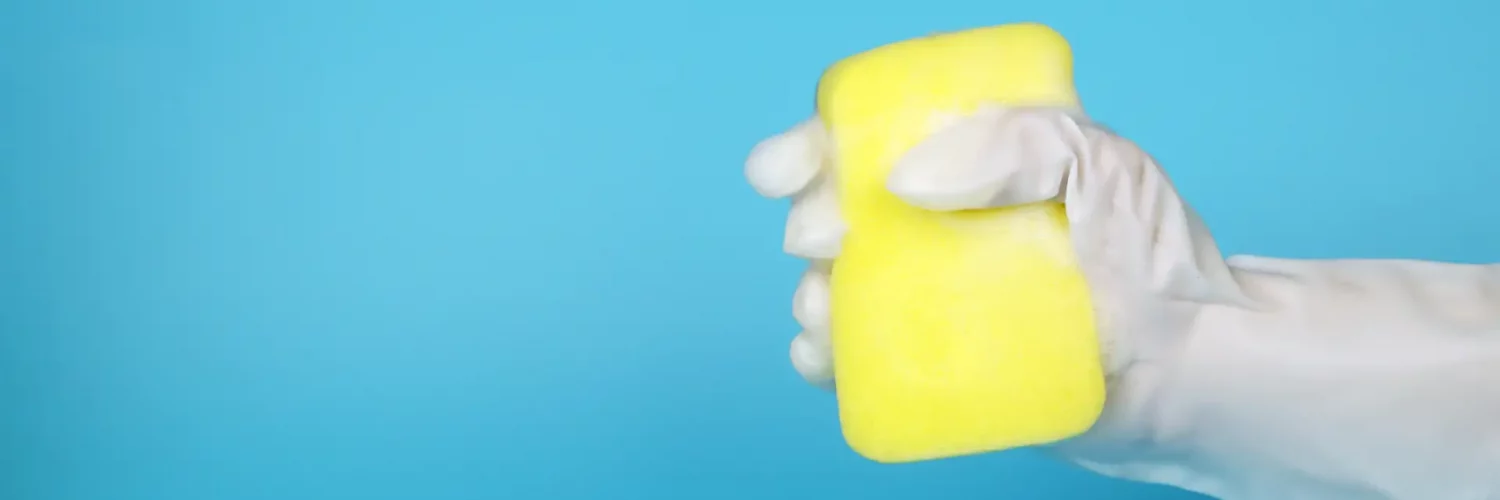Many medical procedures require cleansing to create a sterile field for surgery or wound treatment. May a sponge be used for this process on Shabbos?
The Mishna states (Shabbos 143a):
A sponge – if it has a leather handle one may clean with it; if not, one may not clean with it.
Rashi explains that when a sponge lacks a handle it is squeezed between one’s fingers. This concern does not exist when the sponge is held by a handle.
The Rambam explains this similarly and elaborates on the Issur of Sechita (Shabbos 22:15):
One who launders is liable for Melaben and one who squeezes clothing is liable for laundering. Therefore, it is forbidden to press a cloth or pad and the like into the mouth of a vessel to stop it up, for perhaps one will come to squeeze it. One may only wipe with a sponge if it has a handle and thus will not be squeezed. One may not cover a barrel of water and the like with a garment that is not designated for it, for they made a decree [forbidding it] lest one come to squeeze.
In his comments on the Rambam, the Ra’avad questions the efficacy of a handle. He maintains that a person will still end up squeezing out liquid even if he holds the sponge by its handle. He therefore explains: “I contend that since it has a handle it is akin to a flask full of water that one pours out. However, when there is no handle, it is like a garment and it is thus forbidden to squeeze.”
In other words, the Ra’avad argues with Rashi and the Rambam since a handle does not prevent the sponge from being squeezed. Rather, when a sponge has a handle it is considered a vessel containing water, and, therefore, removing the water is not considered Sechita. However, when it lacks a handle it looks like a garment that is being squeezed.
The Chazon Ish (O.C. 56:5) explains the Ra’avad’sview: When a sponge has a handle it is recognizable that its purpose is to gather and subsequently expunge water. Thus, the water absorbed into it is not Batel to the sponge and its removal does not constitute Sechita. (It is akin to one who opens or closes a door attached to a house; it is not considered Boneh or Soser since this is its designated function.)
The Shulchan Aruch haRav (320:23) explains the Ra’avad differently:
Some say that even when there is a handle it is impossible to wipe without squeezing the sponge. It is nevertheless permissible because the Sechita occurs via the handle; it is thus not called Sechita. It is like pouring water out of a flask that does not constitute [the Issur of] Mefarek. However, when there is no handle and it is squeezed by one’s hand, it is forbidden.
The Biur Halacha (320 s.v. “v’Yesh”) explains that there are two types of Sechita: The first is where one intends to squeeze the liquids out of a garment to clean it – this is an Issur of Melaben. The second is where the intention is to utilize the liquid that will be squeezed out, for example, squeezing a fruit to drink its juice – this is an Issur of Dash. He elaborates:
As is known, Rabbenu Tam et. al hold that there are two types of Sechita: Squeezing water [from a garment] is forbidden due to Libun but not Dash, since the water goes to waste, unlike in cases of Dash [where the liquid is retained]. Whereas with other liquids the opposite is true – there is no Libun for they are not used for cleaning, rather the Issur is Dash, like when one squeezes olives and grapes. However, it is only similar to Dash when the person needs the extracted liquid.
Returning to the question of using absorbent materials for sterilization. The Tzitz Eliezer (8:15 – Kuntres Meshivas Nefesh 14:11, discussing sterilizing the area of an injection) rules that there is no concern of Sechita. This is because the cotton wool (or other material) used to absorb the fluid is immediately discarded and the expressed fluid also goes to waste straight away. In such a case, he asserts that “it is not the regular manner of Sechita at all”. He explains that the small amount necessary for sterilization that is not discarded is not of sufficient volume to warrant an Issur Sechita. He adds:
This is aside from the fact that it is not a Psik Reisha, particularly when the [piece of] cotton is large and he only dips a little of it. (Regarding separating the cotton wool from a larger wad, the Sefer Tzur Ya’akov 152 forbids it due to Kore’a, however, in my humble opinion, it is unclear that the wad is considered attached such that breaking off some cotton would be Kore’a. For even when it is one wad it is apparent that they are separate pieces. Many Gedolim told me that they are lenient in this matter but this is not the place to elaborate.)[1]
R’ Shlomo Zalman Auerbach zt”l questioned the Tzitz Eliezer’s contention. Why it is relevant that the cotton is discarded immediately? At the time of usage, it is squeezed to sterilize the skin, seemingly a great need. Why is it considered as if the squeezed fluid goes to waste merely on account of the cotton being discarded?
The Tzitz Eliezer responded (9:17 – Kuntres Refua b’Shabbos 2):
I do not understand. I emphasized that one drop is sufficient for sterilizing the area. That amount will not lead to Sechita by any means. Sterilizing the area is done by merely wiping the moist drop onto it. Only a few drops of the sterilizing fluid are drawn after it which cannot be avoided; they are what could bring about Sechita. Along with my other reasons [for leniency] I pointed out that this squeezed fluid is discarded. In the summary of Halachos (14:23) I also cited a similar Heter of the Igros Moshe.
(See the Sefer Kalkeles Shabbos on Dash which states that when the liquid goes to waste it cannot be compared to Dash; it is thus permissible to press it even when it is a Psik Reisha. See also the Shulchan Aruch O.C. 320:18, 16 and the Magen Avraham and Biur Halacha s.v. “Yesh Mi sheMatir”.)
I emphasized that one may be lenient especially when a large piece of cotton is used. In such a case, the part that is being held remains dry while the wet end is used to wipe lightly; it will then not be a Psik Reisha. This is evident from the Magen Avraham (302:27) who permits wiping a bench with a cloth since it is not a Psik Reisha and one is not particular about the water. See also the Mishna Berura (59).
It should be noted that we have only discussed a case of Sechita that lacks the Shiur of a Grogeres necessary for a Chiyuv. Likewise, we discussed a type of Sechita that many hold is only d’Rabbanan, see the Mishna Berura (320:29). See also Tosfos (Shabbos 144a s.v. “Kevashim”) and the Gilyon R’ Akiva Eiger (128b) who references Tosfos.
However, one must certainly take care not to squeeze the cotton back into the container of fluid. It is therefore preferable, where possible, to clean the area of the injection with something that has an actual handle, or with a non-absorbent material.
R’ Yehoshua Neuwirth zt”l concludes (Shemiras Shabbos Kehilchasa 32:59):
To sterilize the area of an injection, one should pour a little sterilizing fluid on the skin and wipe it with cotton wool or wipes.
[1] See our essay “Torn to Pieces” – Parshas Shelach 5783.












Add comment